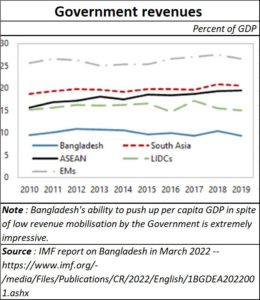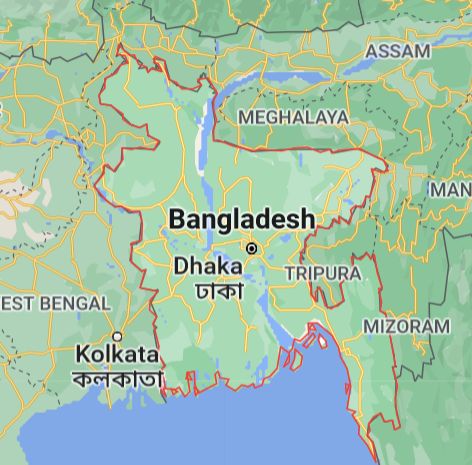https://www.freepressjournal.in/analysis/policy-watch-what-factors-helped-bangladesh-overtake-india-in-per-capita-income
Bangladesh could teach India a thing or two
RN Bhaskar
A few weeks ago, India observers were confronted with numbers that the Indian government had said, unofficially though, would never materialise. But Bangladesh was already nipping at India’s heels even in 2020 (https://asiaconverge.com/2020/05/bangladesh-is-better-than-india-in-education-as-well/). This author had a feeling that it would soon overtake India, unless proper policies were put into place.
 Such apprehensions stand vindicated. Data from the IMF shows how – since 2020 – Bangladesh has managed to post a higher per capita GDP than India, and might continue to be ahead of India — on this number — in the foreseeable future.
Such apprehensions stand vindicated. Data from the IMF shows how – since 2020 – Bangladesh has managed to post a higher per capita GDP than India, and might continue to be ahead of India — on this number — in the foreseeable future.
This is doubly impressive. First, because Bangladesh is puny compared to India, both in terms of size and total GDP. Yet, it has raced ahead and beaten India on the per capita GDP score. India cannot even hide behind the fig leaf that it has a large population. Bangladesh has a significantly higher density of population — of 1,106 people per km2 against 415.4/km2 for India. Had Bangladesh been ‘gifted’ the same density of population that India has, its per capita GDP would have more than doubled, leaving India way behind.
This author had discussions with Bangladeshis in Dubai recently. They lamented the fact that their fellow citizens were leaving Dubai. But why? They said that Bangladesh has begun providing job opportunities that pay at least 600 takas per day even to unskilled workers. Wages are increasing in that country. Dubai has suddenly become less attractive for Bangladeshi migrant workers.
Ask the police in India and they will tell you how the influx of illegal migrants from Bangladesh has declined substantially. Not because our immigration or security officials have become more vigilant, but because their own country offers more opportunities. Instead, you have Biharis from India migrating to Bangladesh nowadays.
So, what was it that Bangladesh did, that India has not been able to do?
First, let us consider areas where Bangladesh does not excel.
 The IMF in its report (https://www.imf.org/-/media/Files/Publications/CR/2022/English/1BGDEA2022001.ashx) points out that Bangladesh needs to reduce financial sector vulnerabilities and develop capital markets, India is way ahead of Bangladesh when it comes to its capital markets and money markets. But that has not stopped investments coming into Bangladesh thanks to the profit potential its government allows to its entrepreneurs.
The IMF in its report (https://www.imf.org/-/media/Files/Publications/CR/2022/English/1BGDEA2022001.ashx) points out that Bangladesh needs to reduce financial sector vulnerabilities and develop capital markets, India is way ahead of Bangladesh when it comes to its capital markets and money markets. But that has not stopped investments coming into Bangladesh thanks to the profit potential its government allows to its entrepreneurs.
The IMF believes that Bangladesh needs to improve its investment climate and boost productivity. It says that higher revenues are necessary to achieve developmental and social targets in a fiscally sustainable way. The government’s ability to raise revenues through taxation is woefully low. It needs to learn from India where the government continues to mobilise higher revenues, even when unemployment remains high, and private incomes have been stunted. But the silver lining here is that this has prevented Bangladesh from fattening its politicians and bureaucrats with huge (official and unofficial) perquisites.
As the IMF puts it, “Revenue as a share of GDP has remained persistently low and trailed behind peers, with the gap relative to the median of other countries in the region and emerging markets (EMs) increasing since 2013. Bangladesh needs to spend more on health, education, and social safety nets and boost investment in infrastructure.” Burt then India’s expenditure on health and education is also dismal ( https://asiaconverge.com/2022/05/india-wont-prosper-till-education-and-employability-improve/).
Moreover, as the IMF report states, “Although the risk of debt distress remains low, risks from a rising debt service-to-revenue ratio have increased, and developmental and priority spending —including to support the recovery—will continue to put pressure on public finances.”
—including to support the recovery—will continue to put pressure on public finances.”
Yet, despite these shortcomings, the government reacted quickly and decisively to address the economic fallout of the pandemic. Remittances surpassed pre-crisis levels, supporting consumption, and moderating the current account (CA) deficit to 1.3 percent of GDP in FY21 from 1.7 percent in FY20. Unlike India, it has a bear regular current account surplus. “However, the current account deficit is projected to widen to 2.4 percent of GDP in FY22 as imports rebound and remittances moderate,” states the IMF.
Growth is expected to pick up to 6.6 percent in FY22 supported by a robust rebound in exports, continued implementation of the  stimulus packages, and accommodative monetary and fiscal policies/. The fiscal deficit is projected to peak at 6.1 percent of GDP in FY22 as the authorities increase pandemic-related spending.
stimulus packages, and accommodative monetary and fiscal policies/. The fiscal deficit is projected to peak at 6.1 percent of GDP in FY22 as the authorities increase pandemic-related spending.
One more factor, which India seldom mentions, is that Bangladesh’s economy has grown because the Sheikh Hasina government (she was prime minister from 1996 to 2001 and once again from 2009 onwards) has refused to allow fundamentalist forces any free rein. Any attempt to polarise people along communal lines is quickly stomped, swiftly and decisively.
This is despite Muslims accounting for almost 90% of the population). Occasionally, when communal fires in India tend to be amplified in Bangladesh, the government moves in and emphatically douses such fires. And surprisingly, despite her party (Awami League) having a grand alliance with 14 other parties, the government has endured.
Bengalis account for almost 98 % of the population and this includes around 8.5% who are Hindus. Other religious minorities include Christians and Buddhists – barely 1% of the population.
Interestingly, the Bangladesh Constitution grants freedom of religion, thus officially becoming a secular state. This is even though Islam is a “state religion.” The government gives every citizen “the right to profess, practise or propagate any religion every religious community or denomination the right to establish, maintain and manage its religious institutions; and states that no person attending any educational institution shall be required to receive religious instruction, or to take part in or to attend any religious ceremony or worship if that instruction, ceremony or worship relates to a religion other than his own”.
Significantly (http://bdlaws.minlaw.gov.bd/), “no person attending any educational institution shall be required to receive religious instruction, or to take part in or to attend any religious ceremony or worship if that instruction, ceremony or worship relates to a religion other than his own.” There is no clamour for reading of the Quran in Hindu schools, or the Gita in Muslim schools.
It is possibly this emphasis on social harmony, and rejection of fundamentalism that has allowed the country to grow economically, despite all the shortcomings pointed out by the IMF. India appears to have forgotten that. The latest edition of The Economist had a bistering indictment against the government on this issue (https://www.economist.com/asia/2022/05/14/how-narendra-modi-is-remaking-india-into-a-hindu-state).
Expect Bangladesh to continue faring well. Any country that ensures that per capita GDP and per capita incomes can be raised year after year, is one that is bound to march ahead.





































COMMENTS